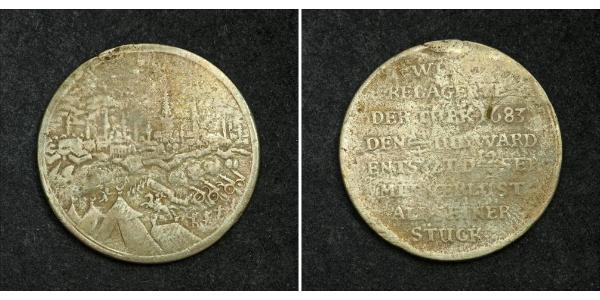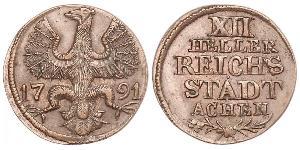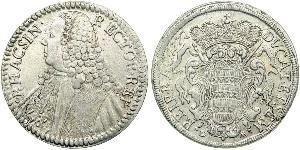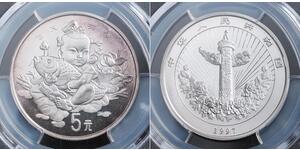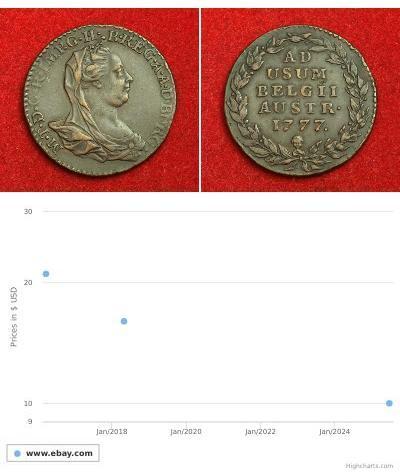(продана за $22.0)
1683, Emperor Leopold I. The Siege & Liberation of Vienna Silver Medal. F+ Mint Year: 1683 Reference: Montenuovo 909, Hirsch 68. R! Condition: Removed suspension loop, otherwise F+ Denomination: Medal - The Siege and Liberation of Vienna and Victory over the Turks (the Ottoman Army). Diameter: 28mm Weight: 6.87gm Material: Silver Obverse: Cityscape with crescent-topped Turkish tents to the fore, cannons firing. Reversse: Legend in eleven lines. All within wreath-border. Legend: WIEN BELAGERTE DER TURK 1683 DEN 14/4 IUL . WARD ENTSEZT D 12/2 SEP. MIT VERLUST ALL SEINER STUCK. Approximate translatation: "The Turk´s siege of Vienna on 14th/4th July was removed on 12th/2th of September with loss of all his Forces" The Battle of Vienna (German: Schlacht am Kahlenberg, Polish: Bitwa pod Wiedniem or Odsiecz Wiedenska, Turkish: Ikinci Viyana Kusatmasi) took place on 12 September 1683 after Vienna had been besieged by the Ottoman Empire for two months. The battle broke the advance of the Ottoman Empire into Europe, and marked beginning of the political hegemony of the Habsburg dynasty in Central Europe. The large-scale battle was won by Polish-Austrian-German forces led by King of Poland John III Sobieski against the Ottoman Empire army commanded by Grand Vizier Merzifonlu Kara Mustafa Pasha. The siege itself began on 14 July 1683, by the Ottoman Empire army of approximately 150,000 men. The besieging force was composed of 60 ortas of Jannisaries (12,000 men paper strength) with an observation army of c.70,000 men watching the countryside. The decisive battle took place on 12 September, after the united relief army of approximately 80,000 men had arrived. The battle marked the turning point in the 300-year struggle between the forces of the Central European kingdoms and the Ottoman Empire. Over the sixteen years following the battle, the Habsburgs of Austria gradually occupied and dominated southern Hungary and Transylvania, which had been largely cleared of the Turkish forces. The main Turkish army finally invested Vienna on 14 July. On the same day, Kara Mustafa sent the traditional demand for surrender to the city. Ernst Rüdiger Graf von Starhemberg, leader of the remaining 11,000 troops and 5,000 citizens and volunteers with 370 cannons, refused to capitulate. Only days before, he had received news of the mass slaughter at Perchtoldsdorf, a town south of Vienna whose citizens had handed over the keys of the city after having been given a similar choice. The Viennese had demolished many of the houses around the city walls and cleared the debris, leaving an empty plain that would expose the Turks to defensive fire if they tried to rush the city. Kara Mustafa Pasha solved that problem by ordering his forces to dig long lines of trenches directly toward the city, to help protect them from the defenders as they advanced steadily toward the city. Although the Turks had 300 good cannons, the fortifications of Vienna were very strong and up to date, and the Turks had to invent a more effective use for their gunpowder: mining. Tunnels were dug under the massive city walls to blow them up with explosives. The lack of urgency by the Ottomans at this point, combined with the delay in advancing their army after declaring war, eventually allowed a relief force to arrive. Historians have speculated that Kara Mustafa wanted to take the city intact for its riches, and declined an all-out attack in order to prevent the right of plunder which would accompany an assault. The Ottoman siege cut virtually every means of food supply into Vienna, and the garrison and civilian volunteers suffered extreme casualties. Fatigue became such a problem that Graf Ernst Rüdiger von Starhemberg ordered any soldier found asleep on watch to be shot. Increasingly desperate, the forces holding Vienna were on their last legs when in August, Imperial forces under Charles V, Duke of Lorraine beat Imre Thököly of Hungary at Bisamberg, 5km northeast of Vienna. On 6 September, the Poles crossed the Danube 30km north west of Vienna at Tulln, to unite with the Imperial forces and additional troops from Saxony, Bavaria, Baden, Franconia and Swabia who had answered the call for a Holy League that was supported by Pope Innocent XI. Only Louis XIV of France, Habsburg's rival, not only declined to help, but used the opportunity to attack cities in Alsace and other parts of southern Germany, as in the Thirty Years' War decades earlier. During early September, the experienced 5,000 Turkish sappers repeatedly blew up large portions of the walls, the Burg bastion, the Löbel bastion and the Burg ravelin in between, creating gaps of about 12m in width. The Austrians tried to counter by digging their own tunnels, to intercept the depositing of large amounts of gunpowder in subterranean caverns. The Turks finally managed to occupy the Burg ravelin and the Nieder wall in that area on 8 September. Anticipating a breach in the city walls, the remaining Austrians prepared to fight in Vienna itself. The relief army had to act quickly to save the city from the Turks, and to prevent another long siege in which they might take it. Despite the international composition and the short time of only six days, an effective leadership structure was established, indisputably centered on the King of Poland and his heavy cavalry. The motivation was high, as this war was not as usual for the interests of kings, but for Christian faith. And, unlike the Crusades, the battleground was in the heart of Europe. Kara Mustafa Pasha, on the other hand, was less effective, despite having months of time to organize his forces, ensure their motivation and loyalty, and prepare for the expected relief army attack. He had entrusted defense of the rear to the Khan of Crimea and his cavalry force, which numbered about 30 - 40,000. There are serious questions as to how much the Tatar forces participated in the final battle at Vienna. Their Khan felt humiliated by repeated snubs by Kara Mustafa. He reportedly refused to attack the Polish relief force as it crossed the mountains, where the Tatar light horse would have that advantage over the Polish heavy cavalry. Nor were they the only component of the Ottoman army to defy Mustafa openly or refuse assignments. This left vital bridges undefended and allowed passage of the combined Habsburg-Polish army, which arrived to relieve the siege. Critics of this account say that it was Kara Mustafa Pasha, and not the Crimean Khan, who was held responsible for the failure of the siege. Also, the Ottomans could not rely on their Wallachian and Moldavian allies. These peoples resented the Ottomans, who extracted heavy tributes from their countries. The Ottomans also intervened in the internal politics of these countries, seeking to replace their ruling princes with men who would be mere Turkish puppets. When George Ducas, Prince of Moldavia and Serban Cantacuzino, Prince of Wallachia learned of the Turkish plans, they tried to warn the Habsburgs. They also tried to avoid participating in the campaign, but the Ottomans insisted that they send troops. There are a great number of popular legends about the Wallachian and Moldavian forces in the siege. Almost invariably, these legends describe them loading their cannons with straw balls, so as to make no impact upon the walls of the besieged city. The Holy League forces arrived on the "Kahlen Berg" (bare hill) above Vienna, signaling their arrival with bonfires. In the early morning hours of 12 September, before the battle, a Mass was held for the King of Poland and his nobles. The battle started before all units were fully deployed. Early in the morning, at 4 AM, the Turks attacked, seeking to interfere with the deployment of the Holy League troops. Charles of Lorraine moved forward with the Austrian army on the left and the German forces in the center. Mustafa Pasha launched a counter-attack, with most of his force, but held back some of the elite Janissary and Sipahiunits for a simultaneous assault on the city. The Turkish commanders had intended to take Vienna before Sobieski arrived, but time ran out. Their sappers had prepared another large and final detonation under the Löbelbastei, to breach the walls. While the Turks hastily finished their work and sealed the tunnel to make the explosion more effective, the Austrian "moles" detected the tunnel in the afternoon. One of them entered and defused the load just in time. At that time, above the "subterranean battlefield", a large battle was going on, as the Polish infantry launched a massive assault upon the Turkish right flank. Instead of focusing on the battle with the relief army, the Turks tried to force their way into the city, carrying their crescent flag. After twelve hours of fighting, the Poles held the high ground on the right. The Holy League cavalry waited on the hills, and watched the infantry battle for the whole day. Then at about 5 PM, the cavalry attacked in four groups. One group was Austrian-German, and the other three were Polish. Over 20,000 men charged down the hills (one of the largest cavalry charges in history). The charge was led by Sobieski at the head of 3,000 Polish heavy lancers, the famed "Winged Hussars". The Lipka Tatars who fought on the Polish side wore a sprig of straw in their helmets to distinguish themselves from the Tatars fighting on the Turkish side. The charge broke the lines of the Ottomans, who were tired from the long fight on two sides. In the confusion, the cavalry headed straight for the Ottoman camps, while the remaining Vienna garrison sallied out of its defenses and joined in the assault. The Ottoman troops were tired and dispirited following the failure of both the sapping attempt and the brute force assault on the city. The arrival of the cavalry turned the tide of battle against them, sending them into retreat to the south and east. In less than three hours after the cavalry attack, the Christian forces had won the battle and saved Vienna. After the battle, Sobieski paraphrased Julius Caesar's famous quote by saying "Venimus, Vidimus, Deus vicit" - "We came, We saw, God conquered". Only 1$ shipping for each additional item purchesed!
читати далі
Ціна

|
Добавив:
anonymous 2015-07-17 |
Similar Coin Groups
2025-05-28
- Покращення Живого Каталогу Монет / поліпшення описів
40 описів монет було покращено з 2025-05-21 по 2025-05-28
Одна з них:
5 Юань Китайська Народна Республіка Срібло
в групі 2 монет
2025-05-25
- Історичні ціни на монету
Можливо, Вас зацікавить...

